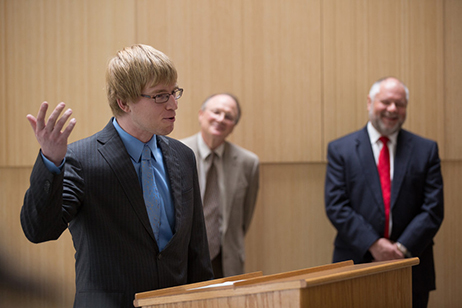Picasolar Expands With Solar Cell Technology Developed at U of A

l-r: Douglas Hutchings, CEO Picasolar; Phil Stafford, president, U of A Technology Development Foundation; Jim Rankin, vice provost for research and economic development
FAYETTEVILLE, Ark. – Picasolar Inc., a solar start-up company affiliated with the University of Arkansas, dedicated its new headquarters on Wednesday at the Arkansas Research and Technology Park.
The 2,300-square-foot space in the Enterprise Center at the technology park allows Picasolar to greatly shorten the time it takes to produce its patent-pending product. That product, called a hydrogen super emitter – improves solar cell efficiency and reduces the amount of silver needed in the manufacture of solar panels, making them more marketable and affordable.
The hydrogen super emitter could save the average solar panel manufacturer up to $120 million annually. The super emitter represents the single largest technology leap in solar power in 40 years, said Douglas Hutchings, Picasolar’s chief executive officer.
“This is a big step for our company,” Hutchings said. “With 1,000 square feet of new lab space, we will accelerate our proprietary process to make solar cells more efficient. The infrastructure and equipment we have assembled will streamline our transition from research and development to commercializing products.”
The University of Arkansas has supported and partnered with Picasolar through its development as a company.
Seth Shumate invented the super emitter as a student at the U of A, and Hutchings and Shumate have both worked closely with Hameed Naseem, a professor of electrical engineering, in the Photovoltaics Research Lab at the Arkansas Research and Technology Park.
The firm’s business plan was honed in the New Venture Development graduate course in the Sam M. Walton College of Business. Competing as a graduate business plan team, Picasolar won more than $300,000 at graduate business plan competitions in 2013, the same year it started operations at the research park.
“It is exciting to see Picasolar continue to grow and be successful,” said Jim Rankin, vice provost for research and economic development at the U of A. “There is a great deal of promising solar research occurring at the University of Arkansas and we look forward to seeing it transition from the lab to the market.”
In 2014, Picasolar raised $1.2 million in equity investments on top of receiving an $800,000 SunShot Initiative award through the U.S. Department of Energy. In April, Picasolar’s super emitter was recognized with a prestigious 2015 Edison Award. The Edison awards, inspired by Thomas Edison’s persistence and inventiveness, recognize innovation, creativity and ingenuity in the global economy.
Hutchings earned a doctorate in microelectronics-photonics at the University of Arkansas in 2010. Shumate earned his doctorate earlier this month from the microelectronics-photonics program, offered by the College of Engineering and J. William Fulbright College of Arts and Sciences.
About the University of Arkansas: The University of Arkansas provides an internationally competitive education for undergraduate and graduate students in more than 200 academic programs. The university contributes new knowledge, economic development, basic and applied research, and creative activity while also providing service to academic and professional disciplines. The Carnegie Foundation classifies the University of Arkansas among only 2 percent of universities in America that have the highest level of research activity. U.S. News & World Report ranks the University of Arkansas among its top American public research universities. Founded in 1871, the University of Arkansas comprises 10 colleges and schools and maintains a low student-to-faculty ratio that promotes personal attention and close mentoring.
Contacts
Douglas Hutchings, chief executive officer
Picasolar Inc.
479-363-1110,
doug@picasolar.com
Chris Branam, research communications writer/editor
University Relations
479-575-4737,
cwbranam@uark.edu